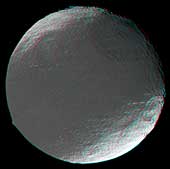|
COMETS EARTH JUPITER KUIPER BELT MARS MERCURY METEORITES NEPTUNE OORT CLOUD PLUTO SATURN SOLAR SYSTEM SPACE SUN URANUS VENUS ORDER PRINTS
PHOTO CATEGORIES SCIENCEVIEWS AMERICAN INDIAN AMPHIBIANS BIRDS BUGS FINE ART FOSSILS THE ISLANDS HISTORICAL PHOTOS MAMMALS OTHER PARKS PLANTS RELIGIOUS REPTILES SCIENCEVIEWS PRINTS
|
Related Document
Download Options
This stereo view of Iapetus was created by combining two Cassini images, which were taken one day apart. The view serves mainly to show the spherical shape of Iapetus and some of the moonís topography. The prominent linear ridge in the center of the dark area -- a place known as Cassini Regio -- marks the equator quite closely. The ridge was first discovered in this set of images and was seen at higher resolution in images taken during Cassiniís flyby of Iapetus on New Yearís Eve 2004. Some Cassini imaging scientists have suggested that the ridge may have a causal relationship to the dark material that coats the moonís leading hemisphere. The mountain on the left is part of the ridge, and rises at least 13 kilometers (8 miles) above the surrounding terrain. The large basin near the terminator (at upper right) was detected in Cassini images from July and has a diameter of about 550 kilometers (340 miles). The large basin at upper left was newly detected in these images. The crater at far right (within the bright terrain) was known from the days of NASA's Voyager missions. North on Iapetus is towards the upper left. The images were obtained in visible light with the Cassini spacecraft narrow angle camera on Dec. 26 and 27, 2004. Cassiniís distance from Iapetus ranged from 880,537 to 716,678 kilometers (547,140 to 445,323 miles) between the two images, and the Sun-Iapetus-spacecraft, or phase, angle changed from 21 to 22 degrees. Resolution achieved in the original images was 5.2 and 4.3 kilometers (3.2 and 2.7 miles) per pixel, respectively. |
